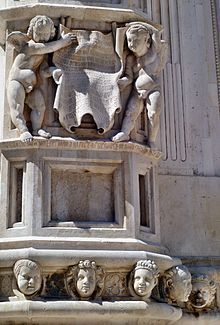
Ancona is a city and a seaport in the Marche region in central Italy, with a population of around 101,997 as of 2015. Ancona is the capital of the province of Ancona and of the region. The city is located 280 km (170 mi) northeast of Rome, on the Adriatic Sea, between the slopes of the two extremities of the promontory of Monte Conero, Monte Astagno and Monte Guasco.
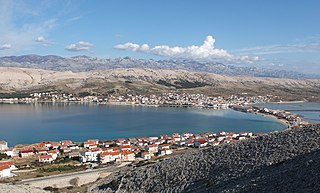
Pag is the largest town on the island of Pag, with a population of 2,343 (2021) in the urban core and 3,178 in the entire municipality.

Trogir is a historic town and harbour on the Adriatic coast in Split-Dalmatia County, Croatia, with a population of 10,923 (2011) and a total municipal population of 13,192 (2011). The historic city of Trogir is situated on a small island between the Croatian mainland and the island of Čiovo. It lies 27 kilometres west of the city of Split.

Šibenik, historically known as Sebenico, is a historic city in Croatia, located in central Dalmatia, where the river Krka flows into the Adriatic Sea. Šibenik is a political, educational, transport, industrial and tourist center of Šibenik-Knin County, and is also the third-largest city in the Dalmatian region. As of 2011, the city has 34,302 inhabitants, while the municipality has 46,332 inhabitants.
Luciano Laurana was an Italian architect and engineer from the historic Vrana settlement near the town of Zadar in Dalmatia, After education by his father Martin in Vrana settlement, he worked mostly in Italy during the late 15th century. He was principal designer of the Palazzo Ducale of Urbino and one of the main figures in 15th-century Italian architecture. He considerably influenced the development of Renaissance architecture. His projects were accompanied with notes in the Croatian glagolitic script, as witnessed by the famous Bernardo Baldi. He was a relative of the sculptor Francesco Laurana.
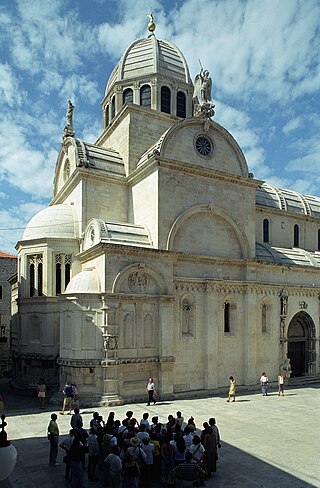
The Cathedral of St. James in Šibenik, Croatia, is a triple-nave Catholic basilica with three apses and a dome. It is the episcopal seat of the Šibenik diocese. It is also the most important architectural monument of the Renaissance in the entire country. Since 2000, the cathedral has been on the UNESCO World Heritage List.
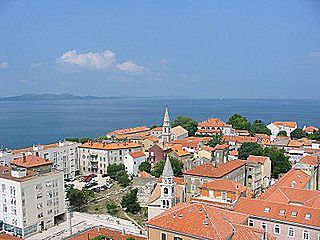
Dalmatian Italians are the historical Italian national minority living in the region of Dalmatia, now part of Croatia and Montenegro.

Niccolò di Giovanni Fiorentino called Nicolas of Florence, was an Italian Renaissance sculptor and architect, active in Venice and Dalmatia.
Croatian art describes the visual arts in Croatia, and art by Croatian artists from prehistoric times to the present. In Early Middle Ages, Croatia was an important centre for art and architecture in south eastern Europe. There were many Croatian artists during the Medieval period, and the arts flourished during the Renaissance. Later styles in Croatia included Baroque and Rococo.
Andrea Alessi was a Venetian architect and sculptor of Albanian descent, considered one of the most distinguished artists of Dalmatia.

Lovro Marinov Dobričević or Lorenzo Bon, Lorenzo di Marino da Cattaro was a painter from Venetian Dalmatia.

The Renaissance in Croatia is a period of cultural enrichment in Croatia that began at the middle of the 15th century and lasted until the end of the 16th century.

San Francesco alle Scale is a church in Ancona, central Italy.

The Loggia dei Mercanti is a historical palace in Ancona, central Italy.
Croats form a part of the permanent population of Italy. Traditionally, there is an autochthonous community in the Molise region known as the Molise Croats, but there are many other Croats living in or associated with Italy through other means. In 2010, persons with Croatian citizenship in Italy numbered 21,079.
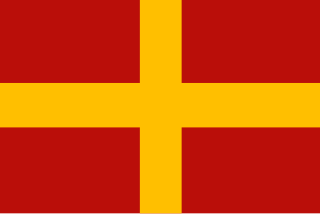
The Republic of Ancona was a medieval commune and maritime republic notable for its economic development and maritime trade, particularly with the Byzantine Empire and Eastern Mediterranean, although somewhat confined by Venetian supremacy on the sea. It enjoyed excellent relations with the Kingdom of Hungary, was an ally of the Republic of Ragusa, and maintained good relations with the Turks. All these relationships enabled it to serve as central Italy's gateway to the Orient.

Giorgio Schiavone, or Juraj Ćulinović, was a Croatian Renaissance painter, active in North Italy and Dalmatia. He is considered the most important Croatian painter of the 15th century.
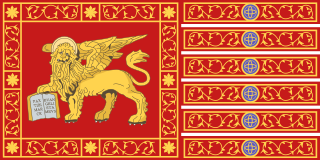
Venetian Dalmatia refers to parts of Dalmatia under the rule of the Republic of Venice, mainly from the 15th to the 18th centuries. Dalmatia was first sold to Venice in 1409 but Venetian Dalmatia was not fully consolidated until 1420. It lasted until 1797, when the Republic of Venice fell to the forces of Napoleon Bonaparte and Habsburg Austria.

Dalmatian city-states were the Dalmatian localities where the local Romance population survived the Barbarian invasions after the fall of the Western Roman Empire in the 400s CE. Eight little cities were created by those autochthonous inhabitants that maintained political links with the Eastern Roman Empire. The original names of these cities were Jadera, Spalatum, Crespa, Arba, Tragurium, Vecla, Ragusium, and Cattarum. The language and the laws were initially Latin, but after a few centuries, they developed their own Neo-Latin language, Dalmatian, which lasted until the 19th century. The cities were maritime centres with huge commerce, mainly with the Italian peninsula and with the growing Republic of Venice.
This is an alphabetical index of people, places, things, and concepts related to or originating from the Republic of Venice. Feel free to add more, and create missing pages.



















